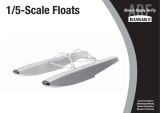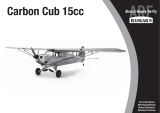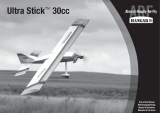La pagina si sta caricando...

1.
2.
3.
4.
5.
6.
7.
8.
HAN Valiant
™
10cc Float Installation • Montage des HAN Valiant
™
10cc Schwimmers
Installation des fl otteurs 10cc HANValiant
™
• Installazione galleggianti HAN Valiant
™
10cc
ENGLISH
1. Use a hobby knife to remove the covering from the slot
toward the rear of the fuselage for the thinner rear strut.
5. Thread one of the mounting screws into the holes.
Remove the screws before proceeding.
2. Use a rotary tool and 1/8-inch (3mm) drill bit to remove
the material inside the fuselage to allow the thinner rear
strut to fi t into the slot.
6. Apply 2-4 drops of thin CA in each hole to harden the
threads in the surrounding wood. Allow the CA to fully
cure before proceeding.
3. Fit the rear strut into the slot. Place the strap so it is
centered forward/back on the gear, and 1/4-inch (6mm)
from the edge of the fuselage. Mark the locations for the
mounting screws on the bottom of the fuselage using a
felt-tipped pen.
7. Attach the strap to the bottom of the fuselage using the
screws included with the straps.
4. Move the strap and use a 5/32-inch (2mm) drill bit to drill
the holes for the screws into the fuselage. Drill for both
straps at this time.
8. Prepare the slot for the thicker front strut by removing
the covering.
REQUIRED ITEMS • ERFORDERLICHE ARTIKEL • ÉLÉMENTS NÉCESSAIRES • ELEMENTI NECESSARI
EFLA5600 Carbon-Z Float Set • Carbon-ZSchwimmersatz • Ensemble de fl otteurs Carbon-Z • Set galleggianti Carbon-Z
EFLA5605 Wire Mounting Set for CZ Cessna 150: Carbon-Z Floats • Kabelbefestigungssatz CZ für Cessna 150: Carbon-ZSchwimmer
Ensemble pour montage de câbles pour CZ Cessna 150: fl otteurs Carbon-Z • Set montaggio fi li per CZ Cessna 150: Galleggianti Carbon-Z
SPMA3001 Heavy-Duty Servo Extension 6-inch • Servokabelverlängerung 150 mm (6 inch) • Rallonge de servo, 151 mm • Estensione servo 6 pollici
DUB158 Gear Strap-Ons • Getriebe-Halteriemen • Pontet de fi xation de trains • Piastrine carrello
1
Valiant
™
10cc Float Installation

9.
10.
11.
12.
13.
14.
15.
16.
17.
14. Slide the fl oat mounts on the struts. Tighten the screws
to secure the fl oats to the struts.
15. Fit the fl oat with the rudder to the struts and cross
braces. Tighten the screws to secure the struts and
braces to the mounts.
16. Use a hobby knife to cut a hole large enough to fi t the
servo lead from the fl oat into the fuselage. Use tape to
secure the lead to the rear strut.
A small amount of silicone adhesive can be used to
seal the hole where the servo lead enters the fuselage.
17. Connect the lead from the fl oat to the receiver using
a 6-inch (150mm) servo lead. Connect the lead to
an unused channel and use programmable mixing to
operate the fl oat rudder.
Use of a “Y” harness will result in the aircraft
rudder and water working in opposite directions. Mixing
will be required to properly operate the water rudder.
9. Fit the thicker front strut into the fuselage. Attach the
straps in the holes used for the landing gear bolts. Use
the bolts included with your model Use a pin vise and
5/32-inch (2mm) drill bit to drill holes for the remaining
landing gear strap screws.
10. Secure the landing gear straps to the fuselage.
11. Attach the fl oat strut mounts to the fl oats following the
instructions included with the fl oats. Position the rear
mount as shown in the photo.
A small amount of silicone adhesive or
tape can be used to seal the unused holes
to prevent water from entering.
12. The front mount can also be installed. Use the photo for
the location of the front mount.
A small amount of silicone adhesive or
tape can be used to seal the unused holes
to prevent water from entering.
13. Fit the cross brace into the mount on the fl oat without
the rudder. Fit both the front and rear cross braces,
tightening the screws onto the fl at areas of the braces.
2

1.
2.
3.
4.
5.
6.
7.
8.
9.
10.
DEUTSCH
1. Mit einem Bastelmesser die Abdeckung vom Rumpf ab
dem Schlitz bis zu dessen Rückseite hin für die dünnere
hintere Verstrebung entfernen.
6. Ca. 2–4 Tropfen dünnen CA-Klebstoff in jedes Loch
auftragen, um das Gewinde im umgebenden Holz zu
härten. Der CA-Klebstoff muss vor dem Fortfahren
vollständig ausgehärtet sein.
2. Ein rotierendes Werkzeug und einen 3mm-Bohrer (1/8
inch), um das Material im Rumpfi nnern zu entfernen,
sodass die dünnere hintere Verstrebung in den Schlitz
passt.
7. Den Riemen unten am Rumpfs mithilfe der den
Halteriemen beigefügten Schrauben befestigen.
3. Die hintere Verstrebung in den Schlitz schieben. Den
Halteriemen so platzieren, dass dieser in der Mitte von
vorn nach hinten über das Getriebe führt und einen
Abstand von 6 mm (1/4 inch) zur Rumpfkante einhält. Die
Position der Montageschrauben mit einem Filzstift an der
Unterseite des Rumpfs markieren.
8. Den Schlitz für die dickere vordere Verstrebung durch
Abnehmen der Abdeckung entfernen.
4. Den Halteriemen abnehmen und mit einem 2mm
(5/32Zoll) Bohrer in den Rumpf Löcher für die Schrauben
bohren. Dabei für beiden Riemen bohren.
9. Die dickere vordere Verstrebung in den Rumpf
einpassen. Die Halteriemen an den Löchern, die für die
Fahrwerkschrauben verwendet werden, befestigen. Die
Ihrem Modell beigefügten Schrauben verwenden Mit
einem Feilkloben und 2-mm-Bohrer (5/32Zoll) Löcher
für die übrigen Halteriemenschrauben des Fahrwerks
bohren.
5. Eine der Montageschrauben in die Locher drehen. Die
Schrauben vor dem Fortfahren entfernen.
10. Die Halteriemen des Fahrwerks am Rumpf sichern.
3
Valiant
™
10cc Float Installation

11.
12.
13.
14.
15.
16.
17.
11. Die Schwimmerverstrebung in den Schwimmern gemäß
den Anweisungen des Schwimmersatzes einbauen. Die
hintere Halterung, wie im Foto dargestellt, positionieren.
Eine kleine Menge von Silikonkleber oder Klebeband
kann zum Abdichten der nicht genutzten Löcher verwendet
werden, damit kein Wasser durch diese eindringen kann.
16. Ein Bastelmesser nutzen, um ein Loch zu schneiden, das
groß genug ist, um die Servoleitung vom Schwimmer
in den Rumpf zu führen. Mit Klarsichtklebeband die
Führung an der hinteren Verstrebung sichern.
Eine kleine Menge von Silikonkleber oder Klebeband
kann zum Abdichten des Lochs verwendet werden,
durch das die Servoleitung in den Rumpf geführt wird.
12. Die vordere Halterung kann ebenfalls montiert werden.
Das Foto für die Positionierung der Halterung nutzen.
Eine kleine Menge von Silikonkleber oder Klebeband
kann zum Abdichten der nicht genutzten Löcher verwendet
werden, damit kein Wasser durch diese eindringen kann.
17. Die Leitung vom Schwimmer mit dem Empfänger mithilfe
einer 150mm (6Zoll) Servoverleitung verbinden. Die
Leitung mit einem nicht genutzten Kanal verbinden und
den programmierbaren Mischer zur Bedienung des
Höhenruders nutzen.
Die Verwendung eines „Y“-Kabelbaums führt dazu,
dass das Seitenruder und das Wasser in entgegengesetzte
Richtungen wirken. Der Mischer ist für das ordnungsgemäße
Funktionieren des Wasserruders erforderlich.
13. Die Querstrebe in die Halterung an dem Schwimmer
ohne das Ruder einpassen. Sowohl die vordere als auch
die hintere Querstrebe einpassen, die Schrauben an den
fl achen Bereichen der Stützen anziehen.
14. Die Schwimmerhalterungen auf die Streben schieben.
Die Schrauben festziehen, um die Schwimmer an den
Verstrebungen zu befestigen.
15. Den Schwimmer mit dem Seitenleitwerk an die
Verstrebungen und Querstreben anpassen. Die
Schrauben festziehen, um die Verstrebungen und
Querstrebungen an den Halterungen zu befestigen.
4

1.
2.
3.
4.
5.
6.
7.
8.
9.
10.
FRANÇAIS
1. Utilisez un couteau pour retirer l’entoilage de la fente
vers l’arrière du fuselage pour le hauban arrière plus fi n.
6. Appliquez 2 à 4gouttes de CA fi ne dans chaque trou
pour durcir les fi letages du bois autour. Avant de
continuer, laissez la CA sécher complètement.
2. Utilisez un outil rotatif et une mèche de 3mm (1/8po)
pour retirer le matériau à l’intérieur du fuselage afi n de
sécuriser le hauban arrière plus fi n dans la fente.
7. Attachez le pontet en bas du fuselage à l’aide des vis
incluses avec les pontets.
3. Fixez le hauban arrière dans la fente. Placez le pontet
de manière à le centrer vers l’avant/l’arrière du train,
et à 6mm (1/4po) du bord du fuselage. Marquez les
emplacements des vis de montage en bas du fuselage à
l’aide d’un stylo-feutre.
8. Préparez la fente pour le hauban avant plus large en
retirant l’entoilage.
4. Déplacez le pontet et utilisez une mèche de 2mm
(5/32po) pour percer les trous des vis dans le fuselage.
Percez pour les deux pontets en même temps.
9. Fixez le hauban plus large dans le fuselage. Fixez les
pontets dans les trous utilisés pour les boulons du train
d’atterrissage. Utilisez les boulons inclus avec votre
modèle. Utilisez un porte-foret et une mèche de 2mm
(5/32po) pour percer les trous pour les vis du pontet du
train d’atterrissage restant.
5. Filetez l’une des vis de montage dans les trous. Retirez
les vis avant de continuer.
10. Fixez les pontets du train d’atterrissage au fuselage.
5
Valiant
™
10cc Float Installation

11.
12.
13.
14.
15.
16.
17.
11. Fixez les supports de contrefi che fl ottant aux fl otteurs
en respectant les instructions incluses avec les fl otteurs.
Placez le support arrière comme illustré dans la photo.
Appliquez une petite quantité de colle
silicone ou du ruban pour sceller les trous non
utilisés afin d’empêcher l’eau d’entrer.
16. Utilisez un couteau pour couper un trou assez grand pour
fi xer le fi l de servo du fl otteur dans le fuselage. Utilisez
de l’adhésif pour fi xer le fi l au hauban arrière.
Appliquez une petite quantité de colle silicone pour
sceller le trou où le fil du servo entre dans le fuselage.
12. Le support avant peut également être installé. Utilisez
une photo pour connaître l’emplacement du support
avant.
Appliquez une petite quantité de colle
silicone ou du ruban pour sceller les trous non
utilisés afin d’empêcher l’eau d’entrer.
17. Raccordez le fi l du fl otteur au récepteur en utilisant un fi l
de servo de 150mm (6po). Raccordez le fi l à un canal
non utilisé et utilisez un mixage programmable pour
utiliser le gouvernail des fl otteurs.
Lorsque vous utilisez un harnais en Y, le
gouvernail de l’appareil et l’eau fonctionnent dans
des directions opposées. Un mixage sera requis pour
utiliser correctement le gouvernail hydraulique.
13. Fixez l’entretoise au support sur le fl otteur sans le
gouvernail. Fixez les entretoises avant et arrière, en
serrant les vis dans les surfaces planes des renforts.
14. Faites glisser les supports plats aux haubans. Serrez les
vis de fi xation pour fi xer les fl otteurs aux haubans.
15. Fixez le fl otteur avec le gouvernail aux haubans et
entretoises. Serrez les vis de fi xation pour fi xer les
haubans et les renforts aux supports.
6

1.
2.
3.
4.
5.
6.
7.
8.
9.
10.
ITALIANO
1. Con un taglierino, rimuovere il rivestimento dalla
scanalatura situata nella parte posteriore della fusoliera
per il montaggio del montante posteriore più sottile.
6. Applicare 2-4 gocce di colla cianoacrilica a bassa
viscosità in ciascun foro per rinforzare i fi letti nel legno
circostante. Prima di procedere, lasciare asciugare
completamente la colla cianoacrilica.
2. Utilizzare un trapano e una punta da 3 mm per rimuovere
il materiale all’interno della fusoliera per consentire il
montaggio nella scanalatura del montante posteriore più
sottile.
7. Fissare la piastrina al fondo della fusoliera utilizzando le
viti in dotazione insieme alle piastrine.
3. Montare il montante posteriore nella scanalatura.
Posizionare la piastrina in modo che sia centrata in modo
accurato rispetto al carrello e a 6 mm dal bordo della
fusoliera. Con un pennarello, contrassegnare la posizione
delle viti di montaggio sul fondo della fusoliera.
8. Rimuovendo il rivestimento, preparare la scanalatura per
il montante anteriore di maggior spessore.
4. Spostare la piastrina e utilizzare una punta da 2 mm per
realizzare nella fusoliera i fori per le viti. In questa fase
effettuare i fori per entrambe le piastrine.
9. Montare il montante anteriore di maggior spessore nella
fusoliera. Fissare le piastrine nei fori utilizzati per i bulloni
del carrello di atterraggio. Utilizzare i bulloni in dotazione
al proprio modello. Utilizzare un minitrapano e una punta
da 2 mm per effettuare i fori per le rimanenti viti per le
piastrine del carrello di atterraggio.
5. Avvitare una delle viti di montaggio nei fori. Prima di
procedere rimuovere le viti.
10. Fissare alla fusoliera le piastrine del carrello di
atterraggio.
7
Valiant
™
10cc Float Installation

© 2017 Horizon Hobby, LLC.
Hangar 9 and Valiant are trademarks or registered trademarks of Horizon Hobby, LLC.
Job #56841 Created 11/2017
11.
12.
13.
14.
15.
16.
17.
11. Seguendo le istruzioni incluse con i galleggianti, fi ssare
i supporti dei montanti dei galleggianti. Posizionare il
supporto posteriore come mostrato nella fi gura.
È possibile utilizzare una piccola quantità di
adesivo al silicone o del nastro per sigillare i fori
non utilizzati per impedire l’ingresso dell’acqua.
16. Utilizzare un taglierino per realizzare un foro grande
a suffi cienza per il montaggio del cavo del servo dal
galleggiante fi no all’interno della fusoliera. Utilizzare del
nastro per fi ssare il cavo al montante posteriore.
È possibile utilizzare una piccola quantità
di adesivo al silicone per sigillare il foro dove
il cavo del servo entra nella fusoliera.
12. È possibile installare anche il supporto anteriore.
Utilizzare la fi gura per il posizionamento del supporto
anteriore.
È possibile utilizzare una piccola quantità di
adesivo al silicone o del nastro per sigillare i fori
non utilizzati per impedire l’ingresso dell’acqua.
17. Collegare il cavo proveniente dal galleggiante al
ricevitore utilizzando un cavo del servo da 150 mm.
Collegare il cavo a un canale non utilizzato e servirsi
della miscelazione programmabile per azionare il timone
del galleggiante.
L’utilizzo di una prolunga a Y provocherebbe
un’azione del timone dell’aeromodello opposta a
quella dell’acqua. Per azionare in modo corretto il
timone nell’acqua è necessaria la miscelazione.
13. Montare il sostegno trasversale nel supporto sul
galleggiante senza il timone. Montare sia i sostegni
trasversali anteriori che quelli posteriori, serrando le viti
sulle aree piatte dei sostegni.
14. Far scorrere sui montanti i supporti dei galleggianti.
Serrare le viti per fi ssare i galleggianti ai montanti.
15. Montare il galleggiante con il timone ai montanti e ai
sostegni trasversali. Serrare le viti per fi ssare i montanti
e i sostegni ai supporti.
8
1/8




